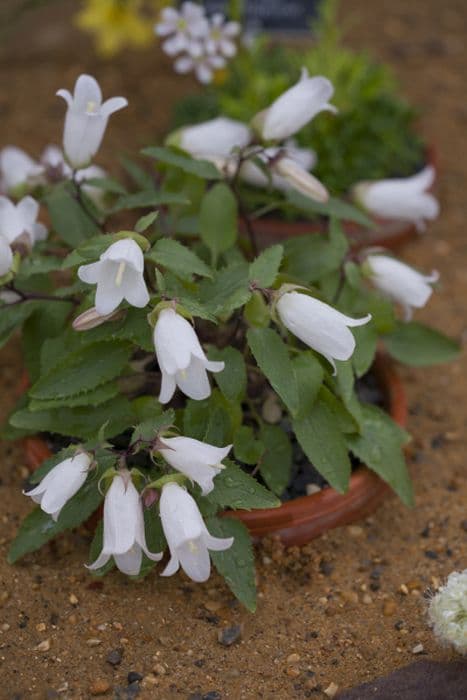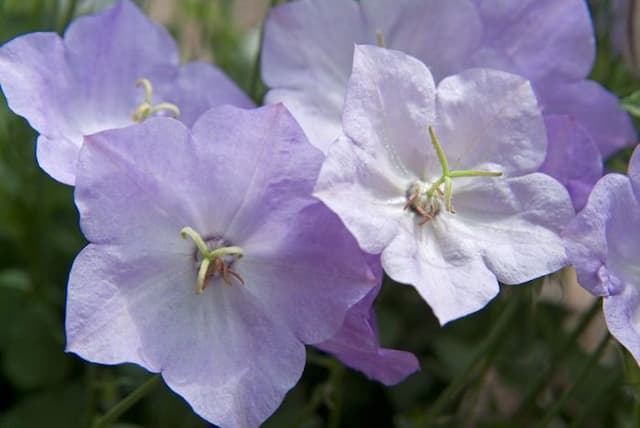Great Bellflower Campanula latiloba 'Highcliffe Variety'

ABOUT
The Campanula latiloba 'Highcliffe Variety', more commonly known as the bellflower, boasts a striking appearance characterized by a profusion of large, upturned bell-shaped flowers that enchant with a rich violet-blue hue. These captivating blooms cluster atop strong, upright stems, lending an air of cottage garden charm to any planting space. The foliage of the bellflower is equally lush, comprising of broad, green leaves that form a low mound at the base. These leaves provide a verdant backdrop that emphasizes the vibrant color of the flowers, making them stand out even more prominently. The leaves may vary in shape from heart to lanceolate, with serrated edges adding texture to the plant's overall look. Together, the contrast between the intense blue of the flowers and the verdant green of the leaves creates a visually harmonious aesthetic. The bellflower's bloom season enriches gardens with a long-lasting display of color and form, making it a cherished choice among garden enthusiasts looking for perennial beauty.
About this plant
 Names
NamesFamily
Campanulaceae
Synonyms
Great Bellflower, Broad-leaved Bellflower, Highcliffe Bellflower
Common names
Campanula latiloba.
 Toxicity
ToxicityTo humans
The plant commonly known as the Great Bellflower is generally not considered toxic to humans. There are no well-documented cases of poisoning from ingestion of any part of this plant, and it is usually regarded as safe in a garden setting. Hence, there should be no significant consequences from ingesting this plant for most individuals.
To pets
The Great Bellflower is also not considered toxic to pets. It is unlikely to cause any serious symptoms of poisoning if ingested by animals such as cats or dogs. As with humans, the ingestion of any part of this plant should not result in any severe health consequences for pets. However, individual animals might have different sensitivities, and it is always prudent to monitor pets for any signs of distress after ingestion of plant material.
 Characteristics
CharacteristicsLife cycle
Perennials
Foliage type
Deciduous
Color of leaves
Green
Flower color
Blue
Height
2-3 feet (60-90 cm)
Spread
1-2 feet (30-60 cm)
Plant type
Herb
Hardiness zones
5
Native area
Europe
Benefits
 General Benefits
General Benefits- Adds visual interest to gardens with its tall spikes of violet-blue flowers, creating a striking display.
- Attracts pollinators like bees and butterflies, helping to support local ecosystems.
- Easy to care for and relatively low maintenance, suitable for novice gardeners.
- Perennial nature means it returns year after year, providing long-term value for the garden.
- Tolerates a range of soil types, making it adaptable to different garden conditions.
- Can thrive in both full sun and partial shade, offering flexibility in garden placement.
- Its clump-forming habit can help control soil erosion in the garden landscape.
- Works well in mixed borders, cottage gardens, and as cut flowers due to its height and color.
 Medical Properties
Medical PropertiesThis plant is not used for medical purposes.
 Air-purifying Qualities
Air-purifying QualitiesThis plant is not specifically known for air purifying qualities.
 Other Uses
Other Uses- Campanula latiloba 'Highcliffe Variety', or the Great Bellflower, can be used in fairy gardens due to its enchanting bell-shaped flowers which add a touch of magic and whimsy.
- The dried petals of the Great Bellflower can serve as a natural confetti for weddings and celebrations, providing a biodegradable and eco-friendly alternative to traditional paper confetti.
- With its tall and robust growth, the Great Bellflower can be used as a natural support for smaller, climbing plants in the garden that may need assistance reaching sunlight.
- An infusion of the leaves and flowers can be used as a rinse for pets to give their fur a mild floral fragrance and potentially deter certain pests.
- The Great Bellflower can be pressed and included in botanical art pieces or homemade paper, adding texture and color to the crafts.
- The vibrant flowers can be used to create natural dyes for textiles, yielding shades of blue and purple depending on the mordant used.
- Its stems can be incorporated into homemade wreaths and other floral arrangements, providing structure and height to the compositions.
- When in bloom, the Great Bellflower can be placed in rooms to provide a subtle and pleasant natural scent, acting as a fresh alternative to commercial air fresheners.
- The plant's robust nature enables it to act as a natural erosion control method on slopes and banks where soil retention is needed.
- The leaves of the Great Bellflower can be included as part of compost or mulch, contributing essential nutrients to the soil as they decompose.
Interesting Facts
 Feng Shui
Feng ShuiThe Great Bellflower is not used in Feng Shui practice.
 Zodiac Sign Compitability
Zodiac Sign CompitabilityThe Great Bellflower is not used in astrology practice.
 Plant Symbolism
Plant Symbolism- Perseverance: Campanula latiloba, commonly known as the 'Great Bellflower', often grows in tough conditions and keeps flowering, symbolizing the ability to endure and maintain beauty through hardship.
- Constancy and fidelity: The 'Great Bellflower' has been associated with steadfastness in love and the constant nature of affection, which is presumably linked to how reliably it blooms every year.
- Gratitude: In the language of flowers, bellflowers, including 'Great Bellflower', are often given to express gratitude, suggesting appreciation for a kind act or support received.
- Humility: The bell shape of the flowers, which hang down as if in a bowing posture, can represent humility, conveying modesty and a down-to-earth nature.
- Hope: The 'Great Bellflower' can be a symbol of hope, reflecting the idea of looking forward to good things and staying optimistic about the future.
 Water
WaterThe Great Bellflower should be watered deeply to encourage root growth, and the soil should be kept evenly moist but not waterlogged. During the growing season, watering once a week with about one to two gallons per plant should suffice, adjusting for rain, heat, and soil conditions. In periods of drought or extreme heat, increase watering frequency, but always check the soil moisture. Overwatering can lead to root rot, so ensure good drainage and reduce watering as the plant goes dormant in the fall.
 Light
LightThe Great Bellflower thrives in full sun to partial shade. The ideal location would receive morning sunlight with some afternoon shade, especially in hotter climates. Too much shade can lead to leggy growth and fewer flowers, while too much intense sun can stress the plant.
 Temperature
TemperatureThe Great Bellflower tolerates a wide range of temperatures but performs best at temperatures between 60°F to 75°F. It can survive minimum winter temperatures down to about -30°F and can handle summer heat well if adequately watered. The plant will go dormant in temperatures below freezing, resuming growth in the spring.
 Pruning
PruningPruning the Great Bellflower encourages a more compact growth habit and can stimulate a second bloom in some cases. After the first flush of flowers has finished, cut back the spent flower stems to the base of the plant. Deadheading throughout the growing season can also promote additional blooms. Pruning is best done in late winter or early spring, just before new growth begins.
 Cleaning
CleaningAs needed
 Soil
SoilThe best soil mix for the Great Bellflower is one that is rich, well-draining, and has some added organic matter. A mixture consisting of garden soil, peat moss or compost, and perlite or sand would provide an appropriate structure and fertility. The ideal soil pH for this plant ranges from 6.0 to 7.5, which supports healthy root growth and nutrient uptake.
 Repotting
RepottingThe Great Bellflower doesn't require frequent repotting and can often be left undisturbed for several years. Generally, repotting every 3 to 4 years is sufficient unless the plant shows signs of being root-bound or the soil has degraded significantly.
 Humidity & Misting
Humidity & MistingThe Great Bellflower thrives in average to slightly above average humidity levels. It is adaptable to typical outdoor humidity conditions and does not require special considerations for humidity when grown in its natural outdoor environment.
 Suitable locations
Suitable locationsIndoor
Place in bright, indirect light; water when topsoil is dry.
Outdoor
Plant in partial sun; protect from strong winds.
Hardiness zone
3-8 USDA
 Life cycle
Life cycleThe life of the Campanula latiloba 'Highcliffe Variety', also known as the Great Bellflower or 'Highcliffe Variety', begins with seed germination, which occurs in a cool, well-drained location with some moisture. Following germination, seedlings develop into rosettes of foliage in the first growing season, often requiring a period of vernalization (cold treatment) to initiate flowering in future seasons. The plant then enters the vegetative stage, where it continues to grow and produce more leaves, preparing for the reproductive stage. During the flowering stage, typically in early to mid-summer, the plant produces tall spikes adorned with large, bell-shaped violet-blue flowers that attract various pollinators. After pollination, the plant sets seed, which are distributed to new locations, allowing the cycle to begin anew. In the subsequent years, the Great Bellflower behaves as a perennial, with the existing root system producing new growth each spring from overwintered vegetative parts.
 Propogation
PropogationPropogation time
Spring-Early Summer
The Campanula latiloba, commonly known as the Great Bellflower 'Highcliffe Variety', is often propagated by division, which is the most popular method for this perennial plant. The best time to undertake this task is either in the spring as the plants emerge from dormancy or in the early fall when the growing season is winding down. To propagate by division, carefully dig up the parent plant, ensuring you lift a good amount of the root system. Gently separate the plant into smaller sections, each with a part of the root system attached. Replant these sections at the same depth they were previously growing, spacing them about 12 inches (approximately 30 centimeters) apart to allow enough room for growth. Water the newly planted divisions well to help establish them. This method enables gardeners to create new plants that are true to the parent's characteristics and ensures a quicker establishment compared to seed propagation.









![Milky bellflower [Avalanche]](/_next/image?url=https%3A%2F%2Fplants-admin.emdemapps.com%2Fimages%2Fplants%2F%2Fimages%2F604b5dc88c1e7.png&w=640&q=75)